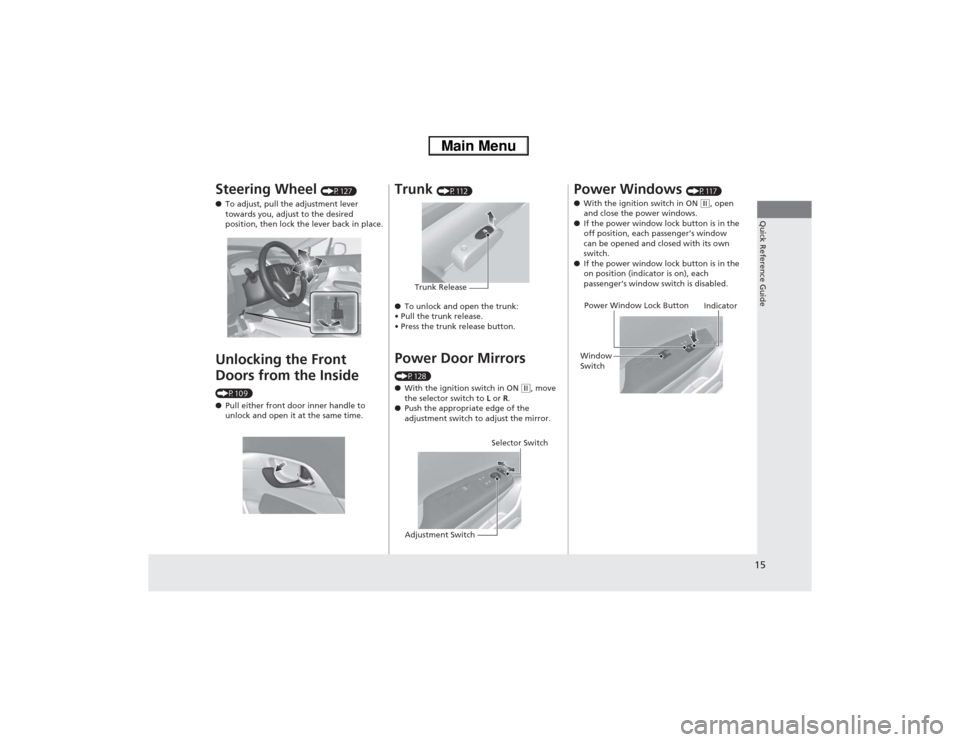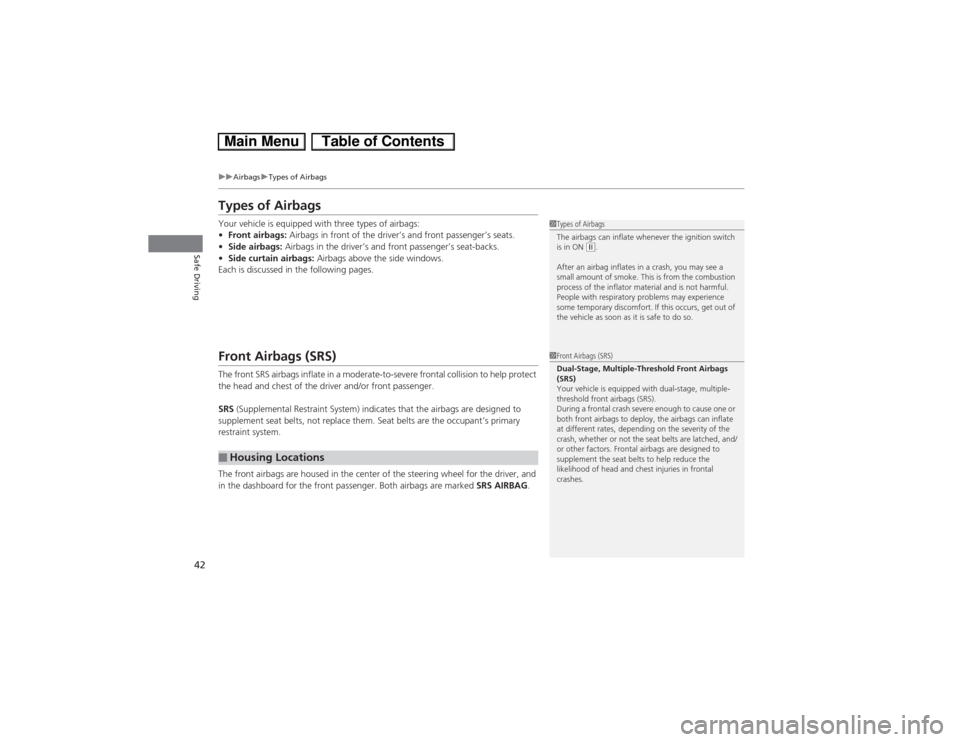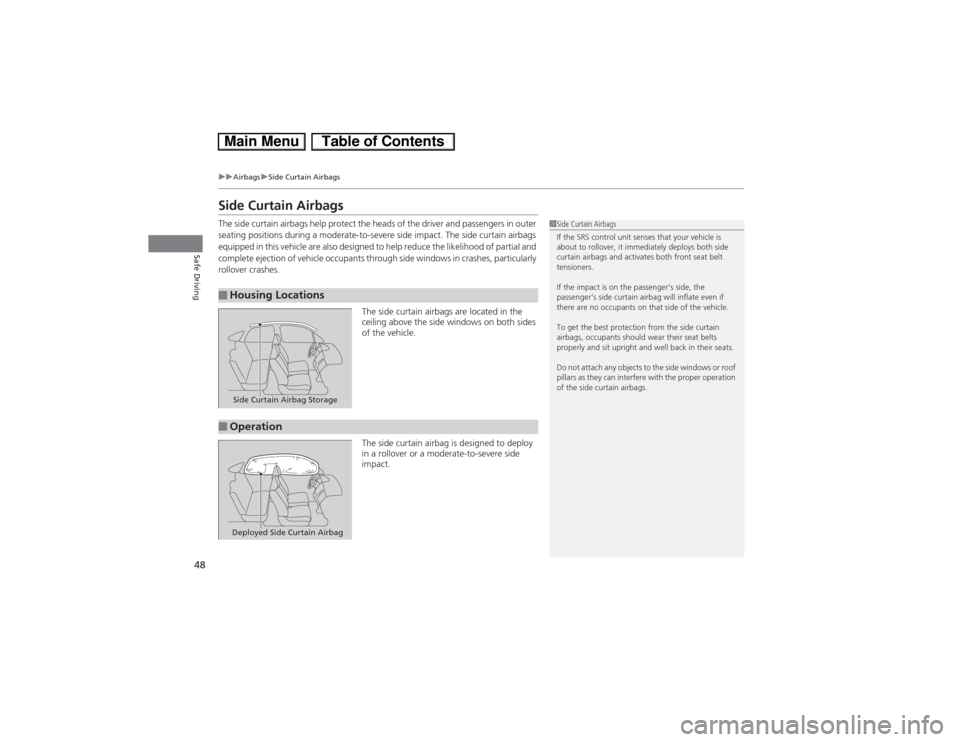Page 2 of 346

Contents
Child Safety P. 52 Exhaust Gas Hazard P. 64 Safety Labels P. 65Opening and Closing the Trunk P. 112 Security System P. 115 Opening and Closing the Windows P. 117
Adjusting the Mirrors P. 128 Adjusting the Seats P. 129
Climate Control System P. 140Audio Error Messages P. 168 General Information on the Audio System P. 171When Driving P. 214 Braking P. 240 Parking Your Vehicle P. 244
Accessories and Modifications P. 250Maintenance Under the Hood P. 259 Replacing Light Bulbs P. 271
Checking and Maintaining Tires P. 279 12 Volt Battery P. 288 Remote Transmitter Care P. 289
Cleaning P. 291Engine Does Not Start P. 311 Jump Starting P. 312 Shift Lever Does Not Move P. 314
Fuses P. 321 Emergency Towing P. 324Devices that Emit Radio Waves P. 329 Reporting Safety Defects P. 330
Authorized Manuals P. 335 Customer Service Information P. 336
Quick Reference Guide
P. 2
Safe Driving
P. 27
Instrument Panel
P. 67
Controls
P. 103
Features
P. 143
Driving
P. 207
Maintenance
P. 251
Handling the Unexpected
P. 295
Information
P. 325
Index
P. 337
Page 3 of 346
2Quick Reference Guide
Quick Reference GuideVisual Index
❙Ignition Switch
(P 119)
❙Steering Wheel Adjustments (P 127)❙System Indicators
(P 68)
❙ECON Button
(P 221)
❙Hazard Warning Button
❙Lane Departure Warning (LDW) Button
* (P233)
❙
(Vehicle Stability Assist (VSA®) System OFF) Button
(P 236)
❙Gauges
(P 82)
❙intelligent Multi-Information
Display (i-MID)
(P 83)
❙Audio System
(P 144)
❙Navigation System
*
() See Navigation System Manual❙Heated Mirror Button
* (P 126)
❙Rear Window Defogger
(P 126)
❙Seat Heater Switches
* (P139)
❙Climate Control System
(P 140)
Page 5 of 346
Visual Index
4Quick Reference Guide
❙Hood Release Handle (P 260)
❙Power Window Switches
(P 117)
❙Power Door Lock Master Switch
(P 110)
❙Door Mirror Controls
(P 128)
❙Parking Brake
(P 240)
❙Auxiliary Input Jack
(P 146)
❙Glove Box
(P 135)
❙Shift Lever
Automatic Transmission (CVT) (P 219)❙Interior Fuse Box
(P 322)
❙Trunk Release
(P 112)
❙Driver’s Front Airbag
(P 42)
❙Fuel Fill Door Release Handle
(P 247)
❙Driver’s Pocket
❙Rearview Mirror
(P 128)
❙Passenger’s Front Airbag (P 42)❙Accessory Power Socket (P 137)
Page 16 of 346

15Quick Reference Guide
Steering Wheel
(P127)
●To adjust, pull the adjustment lever
towards you, adjust to the desired
position, then lock the lever back in place.
Unlocking the Front
Doors from the Inside (P109)
●Pull either front door inner handle to
unlock and open it at the same time.
Trunk
(P112)
●To unlock and open the trunk:
• Pull the trunk release.
• Press the trunk release button.
Power Door Mirrors (P128)
●With the ignition switch in ON
(w, move
the selector switch to L or R.
●Push the appropriate edge of the
adjustment switch to adjust the mirror.
Trunk Release
Selector Switch
Adjustment Switch
Power Windows
(P117)
●With the ignition switch in ON
(w, open
and close the power windows.
●If the power window lock button is in the
off position, each passenger’s window
can be opened and closed with its own
switch.
●If the power window lock button is in the
on position (indicator is on), each
passenger’s window switch is disabled.
Power Window Lock Button
Window
SwitchIndicator
Page 17 of 346
16Quick Reference Guide
Climate Control System
(P140)
●Press the AUTO button to activate the climate control system.
●Press the button to turn the system on or off.
●Press the button to defrost the windshield.
The climate control system is voice operable. See the navigation system manual for complete details.
(Mode Control) Button
(Rear Window Defogger/
Heated Mirror
*) Button
(Windshield Defroster) ButtonA/C (Air Conditioning) ButtonAir flows from floor and
windshield defroster vents.
Air flows from floor vents.
Air flows from floor and
dashboard vents.
Air flows from dashboard
vents.
(Recirculation) Button
Temperature Control DialAUTO Button (On/Off) Button
Fan Control Dial
Models with navigation system
Page 41 of 346

40
uuAirbagsuAirbag System Components
Safe Driving
The front, front side, and side curtain
airbags are deployed according to the
direction and severity of impact. Both side
curtain airbags are deployed in a rollover.
The airbag system includes: aTwo SRS (Supplemental Restraint System)
front airbags. The driver’s airbag is stored
in the center of the steering wheel; the
front passenger’s airbag is stored in the
dashboard. Both are marked SRS
AIRBAG.bTwo side airbags, one for the driver and
one for a front passenger. The airbags are
stored in the outer edges of the seat-
backs. Both are marked SIDE AIRBAG.cTwo side curtain airbags, one for each
side of the vehicle. The airbags are stored
in the ceiling, above the side windows.
The front and rear pillars are marked
SIDE CURTAIN AIRBAG.
dAn electronic control unit that continually
monitors and records information about
the sensors, the airbag activators, the
seat belt tensioners, and driver and front
passenger seat belt use when the ignition
switch is in ON
(w.
eAutomatic front seat belt tensioners. The
driver’s and front passenger’s seat belts
incorporate sensors that detect whether
or not they are fastened.fA driver’s seat position sensor. If the seat
is too far forward, the airbag will inflate
with less force.gWeight sensors in the front passenger’s
seat. The front passenger’s airbag will be
turned off if the weight on the seat is 65
lbs (29 kg) or less (the weight of an infant
or small child).
hImpact sensors that can detect a
moderate-to-severe front or side
collision.iAn indicator on the dashboard that alerts
you that the front passenger’s front
airbag has been turned off.jAn indicator on the instrument panel that
alerts you to a possible problem with your
airbag system or seat belt tensioners.kA rollover sensor that detects whether
the vehicle is about to roll over.
Page 43 of 346

42
uuAirbagsuTypes of Airbags
Safe Driving
Types of AirbagsYour vehicle is equipped with three types of airbags:
•Front airbags: Airbags in front of the driver’s and front passenger’s seats.
•Side airbags: Airbags in the driver’s and front passenger’s seat-backs.
•Side curtain airbags: Airbags above the side windows.
Each is discussed in the following pages.Front Airbags (SRS)The front SRS airbags inflate in a moderate-to-severe frontal collision to help protect
the head and chest of the driver and/or front passenger.
SRS (Supplemental Restraint System) indicates that the airbags are designed to
supplement seat belts, not replace them. Seat belts are the occupant’s primary
restraint system.
The front airbags are housed in the center of the steering wheel for the driver, and
in the dashboard for the front passenger. Both airbags are marked SRS AIRBAG.■Housing Locations
1Types of Airbags
The airbags can inflate whenever the ignition switch
is in ON
(w.
After an airbag inflates in a crash, you may see a
small amount of smoke. This is from the combustion
process of the inflator material and is not harmful.
People with respiratory problems may experience
some temporary discomfort. If this occurs, get out of
the vehicle as soon as it is safe to do so.
1Front Airbags (SRS)
Dual-Stage, Multiple-Threshold Front Airbags
(SRS)
Your vehicle is equipped with dual-stage, multiple-
threshold front airbags (SRS).
During a frontal crash severe enough to cause one or
both front airbags to deploy, the airbags can inflate
at different rates, depending on the severity of the
crash, whether or not the seat belts are latched, and/
or other factors. Frontal airbags are designed to
supplement the seat belts to help reduce the
likelihood of head and chest injuries in frontal
crashes.
Page 49 of 346

48
uuAirbagsuSide Curtain Airbags
Safe Driving
Side Curtain AirbagsThe side curtain airbags help protect the heads of the driver and passengers in outer
seating positions during a moderate-to-severe side impact. The side curtain airbags
equipped in this vehicle are also designed to help reduce the likelihood of partial and
complete ejection of vehicle occupants through side windows in crashes, particularly
rollover crashes.
The side curtain airbags are located in the
ceiling above the side windows on both sides
of the vehicle.
The side curtain airbag is designed to deploy
in a rollover or a moderate-to-severe side
impact.■Housing Locations
1Side Curtain Airbags
If the SRS control unit senses that your vehicle is
about to rollover, it immediately deploys both side
curtain airbags and activates both front seat belt
tensioners.
If the impact is on the passenger’s side, the
passenger’s side curtain airbag will inflate even if
there are no occupants on that side of the vehicle.
To get the best protection from the side curtain
airbags, occupants should wear their seat belts
properly and sit upright and well back in their seats.
Do not attach any objects to the side windows or roof
pillars as they can interfere with the proper operation
of the side curtain airbags.
Side Curtain Airbag Storage
■OperationDeployed Side Curtain Airbag